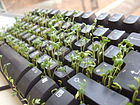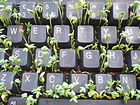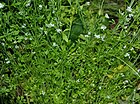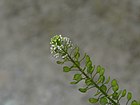Note: This is a project under development. The articles on this wiki are just being initiated and broadly incomplete. You can Help creating new pages.
Lepidium sativum - Charmahantri
Charmahantri is also known as Garden cress, mustard and cress, garden pepper cress, pepperwort pepper grass, chandrashura or poor man's pepper. Garden cress is genetically related to watercress and mustard, sharing their peppery, tangy flavor and aroma.
Contents
[hide]- 1 Uses
- 2 Parts Used
- 3 Chemical Composition
- 4 Common names
- 5 Properties
- 6 Habit
- 7 Identification
- 8 List of Ayurvedic medicine in which the herb is used
- 9 Where to get the saplings
- 10 Mode of Propagation
- 11 How to plant/cultivate
- 12 Commonly seen growing in areas
- 13 Photo Gallery
- 14 References
- 15 External Links
Uses
Asthma, Cough, Snakebites, Counter gout, Skin deseases, Diabates, Scurvy, Diarrhea, Blood pressure.
Parts Used
Chemical Composition
Atropine sulphate, carbachol (CCh), dicyclomine, isoprenaline, verapamil, and rolipram were purchased from Sigma Chemicals Company, St. Louis, MO, USA.[1]
Common names
| Language | Common name |
|---|---|
| Kannada | ಅಲ್ಲಿಬೀಜ Allibeeja, ಕುರ್ಟಿಗೆ ಗಿಡ Kurtige gida |
| Hindi | Akalam, Candsur |
| Malayalam | Asali |
| Tamil | Aali, Aalividai |
| Telugu | Aadithyalu, Aandilee |
| Marathi | Ahaliv |
| Gujarathi | NA |
| Punjabi | NA |
| Kashmiri | NA |
| Sanskrit | Ahaleeva, Asalika |
| English | Common cress, Garden cress |
Properties
Reference: Dravya - Substance, Rasa - Taste, Guna - Qualities, Veerya - Potency, Vipaka - Post-digesion effect, Karma - Pharmacological activity, Prabhava - Therepeutics.
Dravya
Rasa
Katu (pungent)
Guna
Laghu (lightness), Rooksha (dryness), Teekshna (strong, piercing)
Veerya
Ushna (Hot potency)
Vipaka
Katu (pungent)
Karma
Kapha, Vata
Prabhava
Habit
Identification
Leaf
| Kind | Shape | Feature |
|---|---|---|
| Pinnate/Pinnatifid | Alternate | Basal leaves long-petioled, irregularly pinnatifid, drying early; cauline ones sessile, pinnate, less incised with oblong-linear segments, sparsely pubescent with simple hairs; upper ones linear, entire. |
Flower
| Type | Size | Color and composition | Stamen | More information |
|---|---|---|---|---|
| Bisexual | Terminal and axillary racemes | White | 6 | Pedicels cylindric, ascending or subappressed, to 3.5 mm long in fruit, glabrous. Sepals 1.5-1.75 mm long, sparsely pubescent outside. Petals spathulate, somewhat clawed, 2.5-2.75 mm long, sometimes reddish and distinctly nerved. |
Fruit
| Type | Size | Mass | Appearance | Seeds | More information |
|---|---|---|---|---|---|
| Silicula | 5-6 x 3-5 mm across | Compressed, keeled at the back, apex emarginate and broadly winged, glabrous, style about 0.2-0.5 mm long. | {{{5}}} | {{{6}}} |
Other features
List of Ayurvedic medicine in which the herb is used
Where to get the saplings
Mode of Propagation
How to plant/cultivate
An easily grown plant, it succeeds in most soils. For the best results, however, it requires a moist soil and also some shade during the summer to prevent it going straight to seed.[5]
Commonly seen growing in areas
Temperate area, Tropical area.
Photo Gallery
References
External Links
- Ayurvedic Herbs known to be helpful to treat Asthma
- Ayurvedic Herbs known to be helpful to treat Cough
- Ayurvedic Herbs known to be helpful to treat Snakebites
- Ayurvedic Herbs known to be helpful to treat Counter gout
- Ayurvedic Herbs known to be helpful to treat Skin deseases
- Ayurvedic Herbs known to be helpful to treat Diabates
- Ayurvedic Herbs known to be helpful to treat Scurvy
- Ayurvedic Herbs known to be helpful to treat Diarrhea
- Ayurvedic Herbs known to be helpful to treat Blood pressure
- Herbs with Seeds used in medicine
- Herbs with Roots used in medicine
- Herbs with Leaves used in medicine
- Herbs with common name in Kannada
- Herbs with common name in Hindi
- Herbs with common name in Malayalam
- Herbs with common name in Tamil
- Herbs with common name in Telugu
- Herbs with common name in Marathi
- Herbs with common name in Sanskrit
- Herbs with common name in English
- Habit - Annual plant
- Index of Plants which can be propagated by Seeds
- Index of Plants which can be propagated by Cuttings
- Herbs that are commonly seen in the region of Temperate area
- Herbs that are commonly seen in the region of Tropical area
- Herbs
- Brassicaceae











